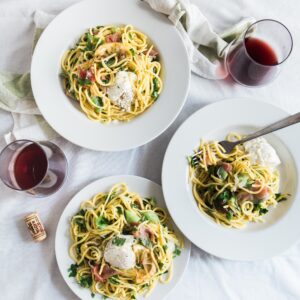 The art of pairing wine with food is much more than an elitist practice—it’s a gateway to elevating your dining experience to new, tantalizing heights. The right combination can bring out hidden flavours, create harmonious taste symphonies, and transform a simple meal into an unforgettable occasion. It doesn’t matter if you’re an aspiring sommelier or a casual wine drinker, knowing how to pair your vino with food can greatly enhance your overall enjoyment and appreciation of both.
The art of pairing wine with food is much more than an elitist practice—it’s a gateway to elevating your dining experience to new, tantalizing heights. The right combination can bring out hidden flavours, create harmonious taste symphonies, and transform a simple meal into an unforgettable occasion. It doesn’t matter if you’re an aspiring sommelier or a casual wine drinker, knowing how to pair your vino with food can greatly enhance your overall enjoyment and appreciation of both.
The Heaviness of the Food
The general rule of thumb is to match light-bodied wines with lighter dishes and heavier, full-bodied wines with heartier meals. If you’re serving a light dish like a salad or grilled fish, a lighter wine like the 36 Degrees North Moscato would be a great choice. This white wine is known for its fruity and floral notes, which complement the delicate flavours of lighter foods. However, if you’re preparing a heavy, hearty dish like steak or stew, you’ll want to choose a fuller-bodied wine like the 2016 Napa Valley Cabernet Sauvignon. This red wine has bolder flavours and higher tannin content, making it a perfect match for rich, meaty dishes.
Consider the Acidity
Acidity in wine can effortlessly cut through the richness of fatty foods, balance out sweet dishes, and stand up to tangy ones. For instance, a high-acid wine like a Sauvignon Blanc or a German Riesling pairs wonderfully with dishes drenched in rich, creamy sauces or laden with cheese, as the wine’s acidity cuts through the richness and resets your palate so that each bite as exciting as the first. When pairing with acidic foods like tomato-based pasta or lemony chicken, you want to choose a wine with equal or higher acidity to prevent it from tasting flat. A wine’s acidity can elevate the flavours of the dish when paired correctly.
Balance Flavours
The goal is to bring out the best characteristics of the wine and the meal without one overpowering the other — and here’s where balancing flavours comes into play. Spicy foods pair well with a sweet wine like Gewürztraminer, which can soothe the heat. On the other hand, a dish with a lot of umami—like mushrooms or aged cheeses—can be beautifully complemented by a savory wine suchlike the Pinot Noir. Desserts pose a unique challenge, as the wine should be at least as sweet as the dish to avoid any bitterness or tartness. For example, a chocolate dessert pairs well with a wine like Ruby Port, known for its rich, berry flavours and sweetness.
Complement or Contrast
Depending on the meal and your personal preference, you have the option to either complement or contrast flavours. Complementary pairing means selecting a wine that shares key flavour components with the dish, creating harmony and synergy. A buttery Chardonnay would complement a dish with a creamy sauce. However, sometimes a contrast can highlight the unique characteristics of both the food and the wine. A classic example is pairing a sweet wine with a salty dish like a late-harvest Riesling with blue cheese. The sweet notes of the wine can balance and even enhance the richness of the cheese, thus creating a pleasurable contrast in your palate. Don’t be afraid to experiment and discover new combinations that please your palate.
Regional Pairing
There’s an old saying, “What grows together goes together,” and it has stood the test of time for a reason. The environment that produces the food also influences the flavours of the wines it yields. The grassy notes of a New Zealand Sauvignon Blanc could perfectly complement a dish featuring fresh seafood from the same region. Similarly, a bold Italian Chianti pairs exceptionally well with classic Tuscan dishes like a hearty Bolognese, thanks to its high acidity and tannin content. This approach is sure to enhance your meal and give you a valuable glimpse into the culinary culture and tradition of the region. Remember that regional pairing is a guideline rather than a rigid rule. Always trust your palate and feel free to experiment!
Use an App or Guide
In our digital age, technology can be a reliable friend even when pairing wine and food. There are several apps and online guides available that can help you make the right choice. Some apps like “Wine Ring” or “Hello Vino” offer personalized wine recommendations based on your taste preferences and the meal you’re preparing. You simply enter the type of food you’re having, and the app suggests a selection of wines that pair well with it.
Online guides and blogs, like “Wine Folly,” also offer a wealth of information on this topic, including infographics and detailed articles that can assist you in making the best pairing decision. Even with these digital tools at your fingertips, the most important thing is your personal enjoyment — trust your instincts and deviate from the suggestions if you think you might enjoy something else.
Wine pairing is both a science and an art. It’s a delightful journey of exploration, where each taste and experiment can lead to a whole new discovery. While guidelines and digital tools can steer you in the right direction, remember that the ultimate judge should be your palate. Don’t be confined by the rules – feel free to mix and match until you find the combination that sparks joy for you.


